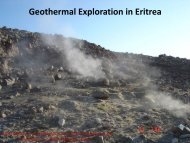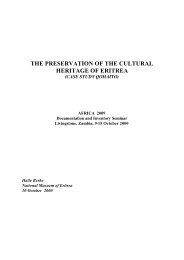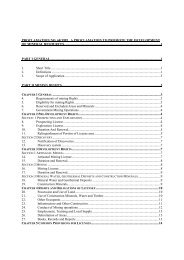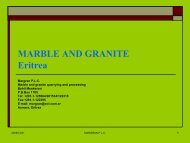Mineral potential of Eritrea
Mineral potential of Eritrea
Mineral potential of Eritrea
- No tags were found...
You also want an ePaper? Increase the reach of your titles
YUMPU automatically turns print PDFs into web optimized ePapers that Google loves.
<strong>Mineral</strong> <strong>potential</strong> <strong>of</strong> <strong>Eritrea</strong>metres was mined. The main quartz vein, about240 metres long, and having an average width <strong>of</strong>10 metres, ends in a stockwork <strong>of</strong> stringers. Themain en-echelon system extends over a strike length<strong>of</strong> 300 metres with widths <strong>of</strong> 20 – 30 metres. Therecovered gold grade is reported to have been 30– 40 grams per tonne and producon during theperiods 1933 – 1941 and 1955 – 1956 is recorded at874 kg, although it is widely believed that the actualproducon was greatly in excess <strong>of</strong> this esmate.The mine was closed in 1941 due to war and all itsmining equipment was removed. It was re-openedbriefly in 1955 to re-treat the tailings. Other interesnglocalies in this belt that reached produc-on include Damishoba, Dase, and Ranyo. Doboro,Tokombia and others were sll at the developmentstage, involving ping and underground explora-on, when the Italian occupaon ended in 1941. Inthe southern part <strong>of</strong> the belt operaons at Antoreand Damanoshila, and in the eastern zone <strong>of</strong> theBerbere River, all were at various stages <strong>of</strong> developmentbefore the Second World War. In the northernpart <strong>of</strong> the belt, at Suzena, prospecng started in1932, and mining was carried out from 1937 – 40.Dri on three levels were developed, but work wasabandoned on the fourth level due to water problems.Gold has also been discovered by the local arsanalminers at a number <strong>of</strong> places in recent mes. Theseare indicaons <strong>of</strong> the high gold potenal <strong>of</strong> the area.Deposits in the Bisha VMS BeltBased on regional works and satellite image interpretaon,the Bisha VMS and associated volcanosedimentarybelt is esmated to have a maximumwidth <strong>of</strong> about 30 kms and extends for more than100 kms to the south, while its northern extensionis not clear. This belt is believed to be highly prospecveand may connue for a substanal distanceto the north as well as to the south. In addion,records <strong>of</strong> past exploraon in this area indicatethat quartz veins with varying gold contents havebeen reported from some locaons including Okere(Okreb). Some <strong>of</strong> these were prospected and exploitedbefore mining stopped due to WWII.Gold & Base Metal Prospects in Southern<strong>Eritrea</strong>There are indicaons <strong>of</strong> the connuity <strong>of</strong> the Asmara/DebarwaVMS belt for long distance to the south.Outcrops are known <strong>of</strong> gossanous rocks, exhala-ves and rock assemblages (felsic and mafic) suchas those <strong>of</strong> the Debarwa area, in the Kena area.There are also many places where local people areconducng arsanal mining. The area west <strong>of</strong> Kenacould represent another belt <strong>of</strong> mineralizaon, asthere are areas <strong>of</strong> recently discovered arsanalworkings south <strong>of</strong> Monsura area, that are its northernextension.Gold & Base Metal mineralisation in Northern<strong>Eritrea</strong>.There are indicaons <strong>of</strong> gold and basemetalmineralizaon in several parts <strong>of</strong> northern <strong>Eritrea</strong>.Old workings and prospects, <strong>of</strong> Italina me arefound in Seroa and Arruba in Harab Suit. There is aCu-mineralizaon along a belt that passes throughRaba and Semait areas where old workings arefound. Gossanous rocks running for hundreds <strong>of</strong>metres occur in Halibet area in farther north.Recent exploraon acvies and the work <strong>of</strong> arsanalminers in Zara and other areas to the north isindicang the presence <strong>of</strong> auriferous quartz veinsand stock works in many areas in this part <strong>of</strong> thecountry.In conclusion, it can be said that mineralizaon inmost part <strong>of</strong> the country is not well studied. It maybe far more complex and extensive than is apparent.The level <strong>of</strong> technology and understanding<strong>of</strong> mineralizaon styles that prevailed during theItalian occupaon was low, and most <strong>of</strong> the historicmines and old mining operaons in <strong>Eritrea</strong> wereinterrupted because <strong>of</strong> the Second World War. Theinvestment climate that existed at the me <strong>of</strong> thestruggle for independence that followed was alsonot conducive to the development <strong>of</strong> these opera-ons. It is therefore, no doubt that this part <strong>of</strong> theregion deserves comprehensive exploraon.18








